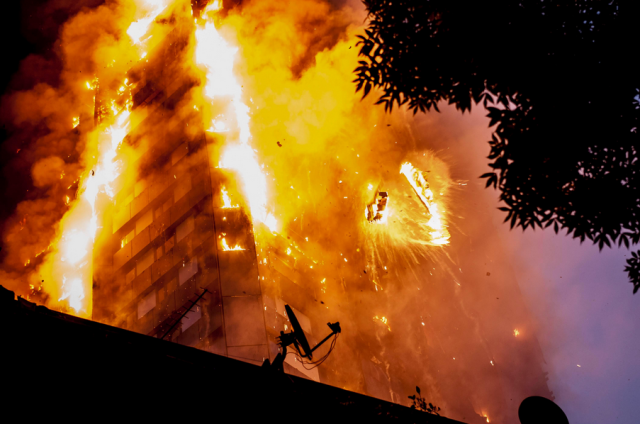
Grenfell Tower aflame in London. (thesun.co.uk)
The Grenfell Tower that burned in London, costing several score of lives, offers lessons that we can and will again fail to heed. No building can be perfectly fireproof, and no ladder truck can reach beyond 20 stories anyhow. If we treated the safety of towers the way we treat, nowadays, the safety of almost everything else, the law would already bar their construction, would have barred it two or three decades ago, especially for the poor. In the case of towers, however, the money interests are even more difficult to defeat than their tenants are difficult to protect. Now the authorities are going after the manufacturers of cladding that stints on safety to achieve low-cost aesthetic relief, on the theory that new crap can improve the appearance of old crap.
As Simon Jenkins points out in his excellent Guardian piece “The lesson from Grenfell is simple: Stop building towers,” London has 400 towers waiting in line for construction when what Londoners – and citizens of cities worldwide – need is neighborhoods. The claim that only skyscrapers can provide the densities cities need to grow is a fraud.
The housing expert Anne Power spoke of the craving of architects and planners at the time for “something distinctive and prestigious.” Architects even invented a vocabulary to justify what was in effect a sales pitch. They would build “vertical streets … villages in the sky … new cities for a new age.” Social consequences were damned. … There is no need to build high at all. The developers’ cry, that cities must build high to “survive,” is self-serving rubbish, the more absurd when their towers are left half-empty. … [T]he most “crowded” parts of London are not around towers but in eight-storey Victorian terraces. The boulevards of central Paris have treble London’s residential density without towers.
Jenkins adds that
[P]eople are entitled to the city they want. When in the 1980s Liverpool’s Militant movement asked Everton’s inhabitants what should be done with their towers, the reply was pull them down and give us back the streets. It was done.
Then, of course, he notes that public housing no longer drives the market for high-rises. No, it is the global rich who want to park their wealth (no doubt honestly accrued!) in a gated apartment they might visit a couple of times a year. I hope that these are built on the sites of old modernist low-rise crap of the sort that London built on Luftwaffe lots for decades before the onrush of towermania. And if – perish the thought – they started building beautiful towers reminiscent of the heyday of Manhattan, then perhaps the case for skyscrapers might carry some weight. But for now, as Jenkins understands, towers are tragedies even if they don’t burn down.
Share this:- More





